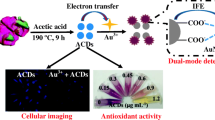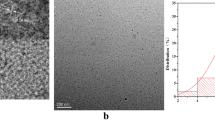Abstract
The study of biologically important Cu2+ and S2− ions has drawn great attention in the recent years since an abnormal level of these ions is an indication for health impairment. Therefore, a reliable strategy for effective fluorescence determination of Cu2+ and S2− ions was developed. Simply, the method based on economical plant-dependent thermolysis procedure for efficient green synthesis of water dispersible luminescent polyamine-based carbon dots (PA@C-dots) utilizes Vitis vinifera juice as precursor with a high quantum yield (32.1%) and good photo-stability. The fluorescent PA@C-dots were characterized by different spectroscopical, physical, and structural techniques. Furthermore, the synthesized PA@C-dots can be used as an efficient dual functional fluorescent probe for the sensitive and selective estimation of Cu2+ and S2− ions. The incorporation of Cu2+ ions and their adsorption on the surface of PA@C-dot skeleton leads to the respectable fluorescence quenching of C-dots (turn-off mode). The Cu2+-PA@C-dot was found to be sensitive to S2− ions. The addition of S2− recovers the fluorescence (turn-on mode) of Cu2+-PA@C-dots, thanks to its capacity for withdrawing Cu2+ from the shell of PA@C-dots. Fluorescence quenching in the range of 0.07–60 μM Cu2+ was obtained with LOD and LOQ of 0.02 and 0.066 μM, respectively. Sulfide detection provides linearity in the range of 0.8 to 95 μM with LOD and LOQ of 0.24 and 0.79 μM, respectively. The optimal excitation and emission wavelengths for all experiments are 435 nm and 498 nm, respectively. Experiment results elucidate that the proposed method is suitable for Cu2+and S2− ion detection in environmental water samples.

Green synthesis of polyamine-functionalized nanoprobe by thermolysis method from plant source as bifunctional sensing platform for determination of Cu2+ and S2− in environmental water samples








Similar content being viewed by others
References
Barceloux DG, Barceloux D. Copper. J Toxicol Clin Toxicol. 1999;37(2):217–30.
Georgopoulos PG, Wang SW, Georgopoulos IG, Yonone-Lioy MJ, Lioy PJ. Assessment of human exposure to copper: a case study using the NHEXAS database. J Expo Sci Environ Epidemiol. 2006;16(5):397–409.
Waggoner DJ, Bartnikas TB, Gitlin JD. The role of copper in neurodegenerative disease. Neurobiol Dis. 1999;6(4):221–30.
Kim MH, Mi HK, Hyun HJ, Sujung Y, Suk-Kyu C, Min SH. Coumarin-derivative-based off–on catalytic chemodosimeter for Cu2+ ions. Chem Commun. 2009;32:4838–40.
Zhu Y, Inagaki K, Chiba K. Determination of Fe, Cu, Ni, and Zn in seawater by ID-ICP-MS after preconcentration using a syringe-driven chelating column. J Anal At Spectrom. 2009;24:1179–83.
Ping L, Xia D, Zhenzhen C, Ying L, Ting X, Libo F, et al. A near-infrared fluorescent probe for detecting copper (II) with high selectivity and sensitivity and its biological imaging applications. Chem Commun. 2011;47:7755–7.
Freedman YE, Ronen D, Long GL. Determination of Cu and Cd content of groundwater colloids by solid sampling graphite furnace atomic absorption spectrometry. Environ Sci Technol. 1996;30:2270–7.
Oliveira PR, Lamy-Mendes AC, Rezende EI, Mangrich AS, Marcolino LH, Bergamini MF. Electrochemical determination of copper ions in spirit drinks using carbon paste electrode modified with biochar. Food Chem. 2015;15(171):426–31.
García IL, Vinas P, Martínez JA. FIA titrations of sulphide, cysteine and thiol-containing drugs with chemiluminescent detection. Fresenius J Anal Chem. 1993;345:723–6.
Balasubramanian S, Pugalenthi V. A comparative study of the determination of sulphide in tannery waste water by ion selective electrode (ISE) and iodimetry. Water Res. 2000;34(17):4201–6.
Laura F, Armas G, José MM, Cerdà EV. A multisyringe flow injection method for the automated determination of sulfide in waters using a miniaturised optical fiber spectrophotometer. Talanta. 2004;64(5):1119–26.
Lawrence NS, Deo RP, Wang J. Electrochemical determination of hydrogen sulfide at carbon nanotube modified electrodes. Anal Chim Acta. 2004;517(1–2):131–7.
Ogasawara Y, Ishii K, Togawa T, Tanabe S. Determination of trace amounts of sulphide in human red blood cells by high-performance liquid chromatography with fluorimetric detection after derivatization with p-phenylenediamine and iron (III). Analyst. 1991;116(12):1359–63.
Wei JJ, Fernández-Argüelles MT, Costa-Fernández JM, Pereiroa R, Sanz-Medel A. Photoactivated luminescent CdSe quantum dots as sensitive cyanide probes in aqueous solutions. Chem Commun. 2005;7:883–5.
Baker SN, Baker GA. Luminescent carbon nanodots: emergent nanolights. Angew Chem Int Ed. 2010;49(38):6726–44.
Mahmoud AM, El-Wekil MM, Mahnashi MH, Ali MFB, Alkahtani SA. Modification of N, S co-doped graphene quantum dots with p-aminothiophenol-functionalized gold nanoparticles for molecular imprint-based voltammetric determination of the antiviral drug sofosbuvir. Microchim Acta. 2019;186:617. https://doi.org/10.1007/s00604-019-3647-7.
Ali HRH, Hassan AI, Hassan YF, El-Wekil MM. Colorimetric and fluorimetric (dual-mode) nanoprobe for the determination of pyrogallol based on the complexation with copper(II)- and nitrogen-doped carbon dots. Microchim Acta. 2019;186:850. https://doi.org/10.1007/s00604-019-3892-9.
Saxena M, Sarkar S. Synthesis of carbogenic nanosphere from peanut skin. Diam Relat Mater. 2012;24:11–4.
Wu M, Wang Y, Wu W, Hu C, Wang X, Zheng J, et al. Preparation of functionalized water-soluble photoluminescent carbon quantum dots from petroleum coke. Carbon. 2014;78:480–9.
Zhu Y, Fan D, Shen W. A general chemical conversion route to synthesize various ZnO-based core/shell structures. J. Phys. Chem. C 2008; 112, 28: 10402–10406.
Khashaba PY, Ali HRH, El-Wekil MM. Simultaneous voltammetric analysis of anti-ulcer and D2-antagonist agents in binary mixture using redox sensor and their determination in human serum. Mat Sci Eng: C. 2017;75:733–41.
Khashaba PY, Ali HRH, El-Wekil MM. Complexation based voltammetric determination of pantoprazole sodium in pharmaceutical formulations and rabbit plasma. Electroanalysis. 2017;29(3):890–7.
Li Z, Youhui L, Zhenzhen H, Jinsong R, Xiaogang Q. Carbon nanodots as fluorescence probes for rapid, sensitive, and label-free detection of Hg2+ and biothiols in complex matrices. Chem Commun. 2012;48:1147–9.
Ganiga M, Cyriac J. Understanding the photoluminescence mechanism of nitrogen-doped carbon dots by selective interaction with copper ions. ChemPhyChem. 2016;17(15):2315–21.
Lingling Z, Yujie H, Zhu Y, Zhai SD. Simple and sensitive fluorescent and electrochemical trinitrotoluene sensors based on aqueous carbon dots. Anal Chem. 2015;87(4):2033–6.
Meng JF, Shi TC, Song S, Zhang ZW, Fang YL. Melatonin in grapes and grape-related foodstuffs: a review. Food Chem. 2017;15(231):185–91.
Kasibabu BS, D’souza SL, Jha S, Kailasa SK. Imaging of bacterial and fungal cells using fluorescent carbon dots prepared from Carica papaya juice. J Fluoresc. 2015;25(4):803–10.
Vaibhavkumar NM, Sanjay J, Rakesh KS, Suresh KK. Preparation of multicolor emitting carbon dots for HeLa cell imaging. New J Chem. 2014;38:6152–60.
He Y, Zhong Y, Peng F, Wei X, Su Y, Lu Y, et al. One-pot microwave synthesis of water-dispersible, ultraphoto-and pH-stable, and highly fluorescent silicon quantum dots. J Am Chem Soc. 2011;133(36):14192–5.
Williams ATR, Winfield SA, Miller JN. Relative fluorescence quantum yields using a computer-controlled luminescence spectrometer. Analyst. 1983;108(1290):1067–71.
Lu W, Qin X, Liu S, Chang G, Zhang Y, Luo Y, et al. Economical, green synthesis of fluorescent carbon nanoparticles and their use as probes for sensitive and selective detection of mercury (II) ions. Anal Chem. 2012;84(12):5351–7.
Igarashi S, Ide N, Takagai Y. High-performance liquid chromatographic–spectrophotometric determination of copper (II) and palladium (II) with 5, 10, 15, 20-tetrakis (4N-pyridyl) porphine following homogeneous liquid–liquid extraction in the water–acetic acid–chloroform ternary solvent system. Anal Chim Acta. 2000;424(2):263–9.
Yu M, Shi M, Chen Z, Li F, Li X, Gao Y, et al. Highly sensitive and fast responsive fluorescence turn-on chemodosimeter for Cu2+ and its application in live cell imaging. Chemistry. 2008;14(23):6892–900.
Lawrence NS, Deo RP, Wang J. Electrochemical determination of hydrogen sulfide at carbon nanotube modified electrodes. Anal Chim Acta. 2004;517(1–2):131–7.
Green NJ, Pimblott SM, Tachiya M. Generalizations of the Stern-Volmer relation. J Phys Chem. 1993;97:196–202.
Dong Y, Wang R, Li G, Chen C, Chi Y, Chen G. Polyamine-functionalized carbon quantum dots as fluorescent probes for selective and sensitive detection of copper ions. Anal Chem. 2012;84:6220–4.
Salinas-Castillo A, Ariza-Avidad M, Pritz C, Camprubí-Robles M, Fernández B, Ruedas-Rama MJ, et al. Carbon dots for copper detection with down and up conversion fluorescent properties as excitation sources. Chem.Commun. 2013;49:1103–5.
Wang Y, Hu A. Carbon quantum dots: synthesis, properties and applications. J Mater Chem C. 2014;2:6921–39.
Griesser R, Sigel H. Ternary complexes in solution. VIII. Complex formation between the copper (II)-2, 2-bipyridyl 1:1 complex and ligands containing oxygen and/or nitrogen donor atoms, Inorg. Chem. 1970; 9: 1238–1243.
Griesser R, Sigel H. Ternary complexes in solution. XI. Complex formationbetween the cobalt (II)-, nickel(II)-, copper(II)-, and zinc(II)-2,2-bipyridyl 1:1complexes and ethylenediamine, glycinate, or pyrocatecholate, Inorg. Chem.1971; 10; 2229–2232.
Author information
Authors and Affiliations
Corresponding author
Ethics declarations
Conflict of interest
The authors declare that they have no conflict of interest.
Additional information
Publisher’s note
Springer Nature remains neutral with regard to jurisdictional claims in published maps and institutional affiliations.
Electronic supplementary material
ESM 1
(PDF 895 kb)
Rights and permissions
About this article
Cite this article
Ali, H.R.H., Hassan, A.I., Hassan, Y.F. et al. Development of dual function polyamine-functionalized carbon dots derived from one step green synthesis for quantitation of Cu2+ and S2− ions in complicated matrices with high selectivity. Anal Bioanal Chem 412, 1353–1363 (2020). https://doi.org/10.1007/s00216-019-02362-4
Received:
Revised:
Accepted:
Published:
Issue Date:
DOI: https://doi.org/10.1007/s00216-019-02362-4




